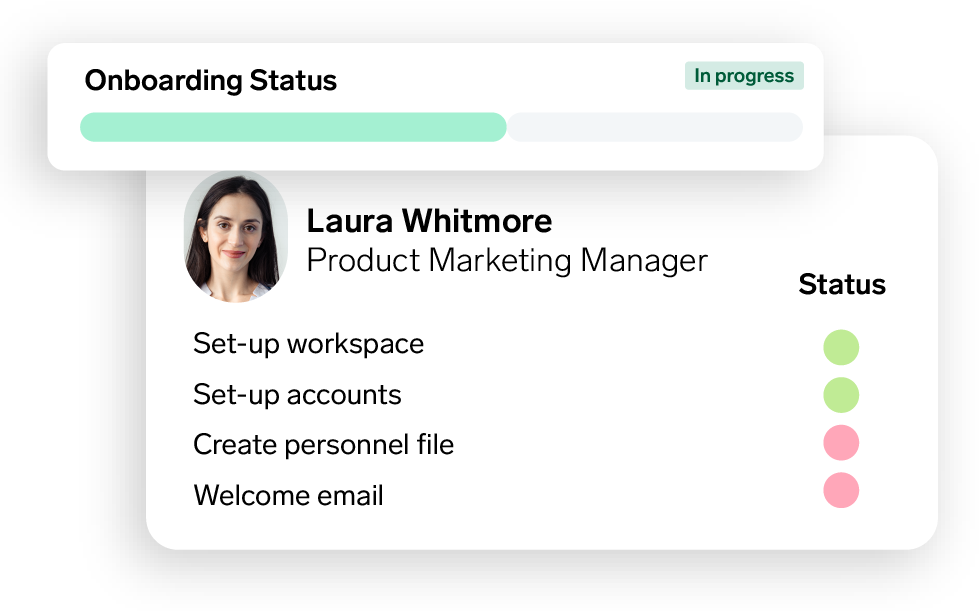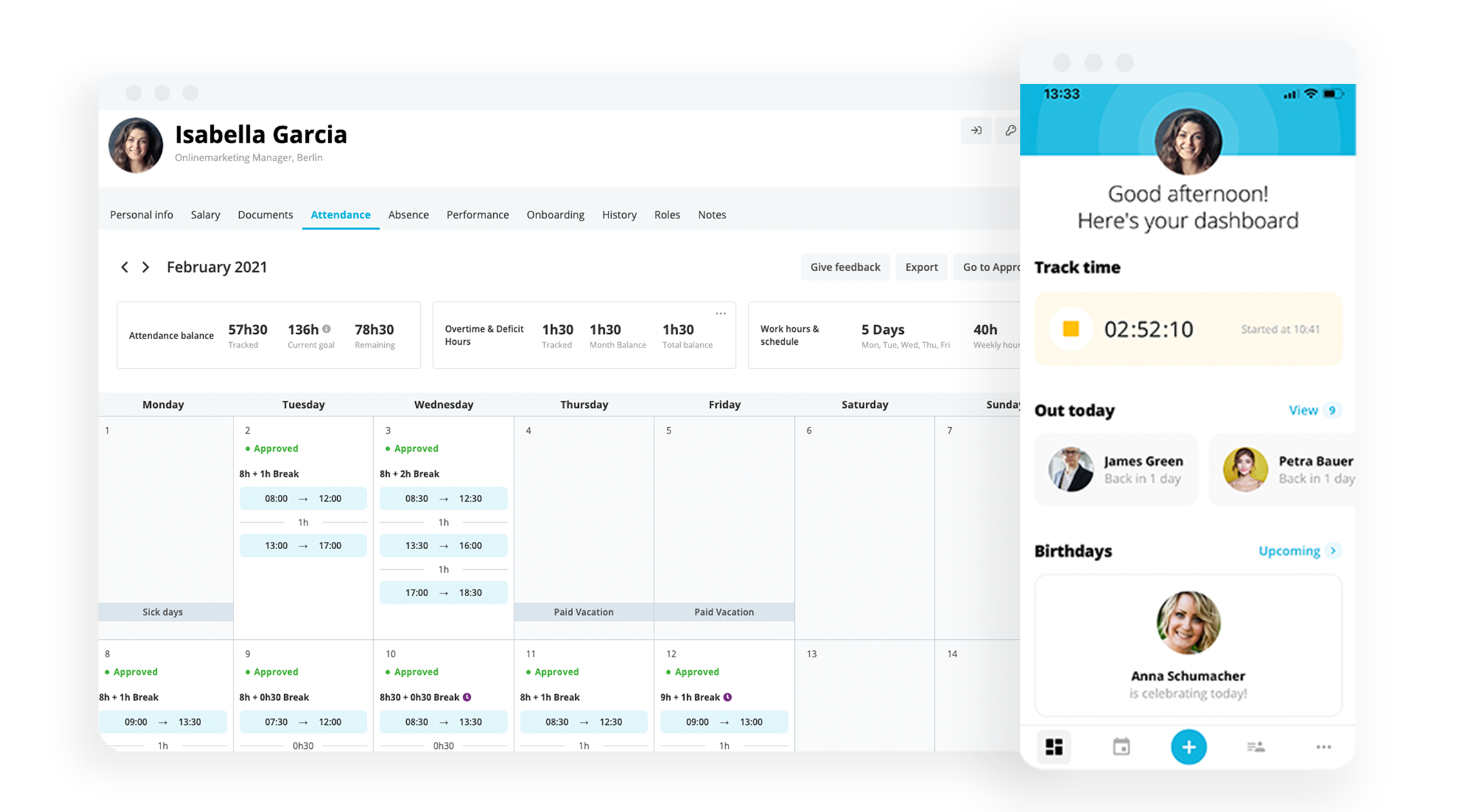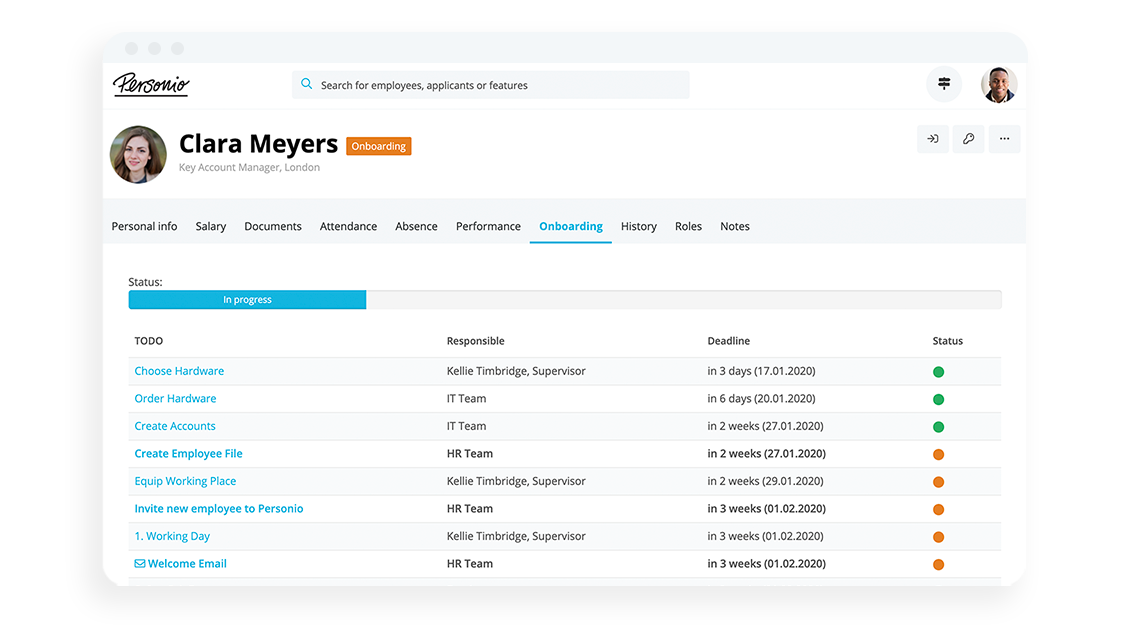
Improve employee onboarding
Discover strategies to enhance your employee onboarding process for a smoother transition.
Read our guideThe Complete Guide to Onboarding New Employees

Effective onboarding is crucial for both the organisation and new hires. A structured onboarding process helps new employees integrate into the company culture, understand their roles and feel welcomed from day one.
This guide aims to help HR teams create an effective onboarding strategy that ensures a smooth transition for new hires and sets them up for long-term success.
Here's how teams can use Personio to run smoother onboarding at scale.What is the onboarding process?
Onboarding is the process of integrating a new employee into an organisation. Its primary goals are to familiarise the new hire with the company culture, values and ways of working, and to ensure they are prepared to perform their role effectively. This involves a series of steps designed to make the new employee feel welcomed and ready to contribute.
The onboarding process typically consists of four stages: pre-boarding, orientation, training and integration (we'll dig into these later). As part of that, the tasks that make up onboarding often include completing paperwork, setting up technology, communicating expectations and organisational structure and making a new colleague feel welcomed.
How long should onboarding take?
Onboarding should typically last between four to eight weeks (dependant on role). After that initial period, you will want to have established some long-lasting processes with employees that no longer require onboarding (instead, they become day-to-day work).
The four phases of the onboarding process
As mentioned above, the onboarding process consists of four key phases: pre-boarding, orientation, training and integration. Each phase plays a vital role in ensuring a comprehensive and effective onboarding experience.
Phase one | Pre-boarding | Before a new employee starts |
Phase two | Orientation | Their first day and week on the job |
Phase three | Training | After their first week of work |
Phase four | Integration | After four to eight weeks |
Phase one: Preboarding
Pre-boarding involves preparing for the new hire’s arrival and ensuring they feel welcomed before their first day. Tasks include sending welcome emails, completing necessary paperwork, setting up technology, and preparing the workplace. This phase is crucial for making the new hire feel valued and excited about joining the team.
Here are some of the common things worth covering during pre-boarding…
Formalities | Have all contractual formalities been taken care of? Have access rights been clarified? Does the new employee have the necessary work attire? These types of questions should be addressed a minimum of one to two weeks before a new colleague starts. |
Orientation information | Does the new employee know when and where to arrive? Does he or she know the essentials of what to expect? This all should be communicated in advance over email (click here for some helpful new employee introduction emails). |
Colleagues and collaborators | All colleagues involved in the process should be provided with all necessary information. In fact, they should be aware of their respective ‘to-do-lists.’ This would typically include secretarial, office management, and IT personnel. It might also be worth considering including mentors who will provide support during the employee’s first few days on the job. |
Workplace wayfinding | Ideally, new employees will arrive on the very first day to a fully functional workplace. Ensuring that everything is in place will require a certain degree of lead time. So, preparations should be made well in advance. |
Relevant deadlines | Invite the new colleague to upcoming meetings. If possible, arrange appointments with the most important people they will be interacting with (in both their own and in other departments). |
Training programmes | Does the new colleague need additional training in a specific area? This training should be booked before the start of employment so that the training period for particular topics is not delayed. |
Role responsibilities | If a new employee is coming into a position that did not previously exist, responsibilities will often be redistributed. The team leader is responsible for communicating this in detail to the current employees. As part of onboarding, the HR manager in charge should double-check to make sure that any potential resentment toward the new colleague is avoided. |
Welcome gift (optional) | The day before the new employee starts, you or one of your colleagues can purchase a little gift to celebrate their start in their new working environment. It could be chocolates, a small bunch of flowers, or something along those lines. You can read below about why this particular point belongs to a successful onboarding experience. |
Phase two: Orientation
Orientation covers the new hire’s first day and week. It includes welcoming the new employee, offering a tour of the office, making introductions, and conducting initial training sessions.
The goal is to make the new hire feel comfortable and part of the team from the start.
Arrival time
To spare your new hire the typical morning chaos, and to carve out sufficient preparation time for yourself, allow them to begin work that day an hour later than usual.
Welcoming culture
From the second they arrive, think of ways to welcome them. Offer them a coffee, a snack or breakfast or a little gift. Make them feel like they're already home.
Introductions

A new hire will be keen to get to know people. To get off to a good start, we'd recommend arranging a small introductory get-together with other new hires or relevant colleagues.
Team bonding
Because nobody enjoys eating alone on their first day! Encourage a line manager or team to host an introductory lunch for their new colleague.
Phase three: Training
Training is an ongoing process that includes role-specific training, compliance training, and providing additional resources the new hire might need. Supervisors and mentors play a key role in this phase, ensuring the new employee understands their responsibilities and expectations.
Onboarding context | To make it clear how things will run over the coming days or weeks, the process should be fully explained to the new employee. This can also be aided by streamlined onboarding software, too. |
Expectation setting | Supervisors should review responsibilities with the employee and communicate their expectations. On the other hand, it is also important that employees be allowed to clearly express their expectations for the next few weeks. |
First asks | New hires should be integrated into existing projects. At the beginning, having exciting initial activities can inspire an employee’s enthusiasm for the company. |
Legal formalities | If there are SOPs (Standard Operating Procedures) associated with the new employee’s work, these must be carefully read and signed before certain activities are performed. |
Company walkthrough | To give the new employee a clear picture of what happens where and who is responsible for each department, a tour to all of the other departments should happen by this point. |
Business introduction | A detailed product or service presentation is an essential element of onboarding. Especially for colleagues from non-customer-facing areas, such as accounting, it is important they know the products/services the company offers. |
Corporate strategy | Be sure that your corporate goals are clear to your new employee: for example, share what you want to achieve in the next quarter and let them know precisely why their contribution will make a difference. |
Corporate culture | Make sure to explain the values that apply to all employees equally. And, in some cases, ensure that your onboarding software also has the opportunity to communicate these things through various documents and materials, too. |
Team spirit | It can often be tough for new colleagues to integrate themselves into existing ‘employee groups.’ Nothing is worse than having to eat lunch alone during the first week of work because, once the first day is over, no one takes responsibility for the new employee. |
Phase four: Integration
Integration extends beyond the initial weeks and involves regular check-ins, feedback sessions, and performance reviews. Continuous support and development are essential to help the new hire fully integrate into the organisation and contribute effectively.
There's two steps that play an important role in this phase:
Gathering first impressions: Gain feedback from your new hire. How are they feeling? What is their overall impression? Could anything be improved? Push for them to give real feedback to help your onboarding process.
Follow-up questions: During the first week, your new employee will have to process a lot of information. Open up space for them to ask any and all questions, free from judgement, to ensure that they know their way around their role and the organisation.
This final phase of onboarding is more of a temperature check. After this, you are more likely to evaluate your new hire as part of the probation review phase. But, in the weeks that follow their start, it's still smart to have a quick check in.
You can do that via:
Ongoing feedback: It is crucial that, after a pre-determined period of time, a feedback session is held with new colleagues, and that this process is repeated regularly. This can often be aided by onboarding software.
Networking: If several colleagues from different departments all start work on the same day, you can promote interdepartmental networking by organising a joint lunch date a few weeks after they have started.
Why does onboarding matter?
Onboarding may be the second phase of the employee lifecycle, but it is important because it can have a long-term effect on employee (and organisational) success.
In fact, one study from the Brandon Hall Group found that great onboarding can boost employee retention rates by upwards of 82%.
If we chart an employee's journey through an organisation, from their first day to their last, we can start to see the ripple effects of great onboarding. This can have an effect on things like satisfaction, engagement and overall productivity.
Is onboarding important for nonprofit organisations?
Onboarding is incredibly important for nonprofits and charities. For many, this is a stage where employees not only learn what they will be doing, but how they will be making a difference.
That in mind, onboarding goes way beyond training someone to do the job at a nonprofit. It also gives them a sense of the organisation’s mission, who they serve, how they help and how it all comes to life.
If you are a nonprofit or charity, it’s crucial to consider how this plays out in your own onboarding process. Here are some things to think about that can help:
Engage new employees before their first day. Invite them to a team outing or something related to your mission. Let them see the work they’ll be contributing to in practice.
Focus on core values. Onboarding can be incredibly overwhelming, so it helps to offer a streamlined understanding of what your organisation stands for and what should guide a new hires decision making.
Bring in team members. You don’t need to leave it to executives, line managers or HR representatives to lead onboarding. Ask other employees to lead sessions or serve as onboarding buddies.
The most important thing to do for nonprofits is to offer a structured, digitised onboarding experience. Employees should know what is expected of them, and when, in a clear and user-friendly way.
HR software that includes employee onboarding can help deliver that experience. It can ensure employees are treated to a consistent and comprehensive process, every time.
To learn a bit more about how Personio supports busy nonprofits with onboarding and other important people processes, click here.
How often should you update your onboarding?
Knowing whether or not it is time to update your onboarding relies on a few questions. The first is asking yourself: is it really working? Are you struggling with early turnover rates? Are employees satisfied?
Your best source of data is your own employees. Continue tapping into this pool of data by establishing some employee resource groups and asking them the following:
How did they find the onboarding process?
Is there anything they would improve?
Did the onboarding process prepare them for their roles?
Did they feel more connected to company culture afterward?
Was the process too long or too short?
Key Insight: It is in your team's best interest to pluck employees from various departments, roles, seniority levels and even differentiate between your top performers and those who may be struggling. Try to identify any inconsistencies in their experiences.
Best practices for great onboarding
Creating an effective onboarding process involves several best practices that HR teams should consider.
Developing a vision for onboarding
Having a clear mission and goals for the onboarding process is essential. Define what you want to achieve and how you want to support new hires. This vision will guide the development and implementation of your onboarding strategy.
Clarifying roles and responsibilities
Clearly define the roles and responsibilities of the new hire and the onboarding team. This includes time-tracking, access cards, employee IDs, office supplies, and more. Ensuring everyone knows their duties helps streamline the process and avoid confusion.
Compiling necessary steps
Create a comprehensive checklist for HR, managers, and teams to cover all administrative, technical, and social responsibilities. This ensures that no steps are missed and that every new hire receives a consistent onboarding experience.
Automating the onboarding process
Utilise HR software to automate tasks and streamline the onboarding process. Tools like Personio can help manage tasks, send automated welcome messages, and schedule status checks and feedback sessions, saving time and ensuring consistency.
HR software like Personio can significantly streamline the onboarding process. Here are some benefits and examples:
Automated task management: Tools like Personio can automatically assign tasks to relevant team members, ensuring nothing is overlooked.
Digital employee files: Maintain all necessary documents in a digital format, accessible to both HR and the new hire.
Automated reminders: Set up reminders for important onboarding milestones, ensuring timely completion of tasks.

Best practices for HR during onboarding
To deliver great onboarding, there are definitely some things like HR professionals, leaders and line managers should keep in mind. Here are some of the best practices that you should be considering today...
Phases are your friend | Craft an onboarding process that covers the different tasks unique onboarding 'phases' that help ground your overall concept. Think of it like this: first impression, first week, first month, first performance check-in, for instance. |
Clarity is key | For example, when it comes to provisioning software access, employee ID cards, office supplies, hardware, etc. The same applies to the provision of data in payroll accounting and the creation of a digital file. Plan realistically for lead times. |
Progress is progress | It seems simple, but it works. Craft a checklist for onboarding so that new employees and managers alike can feel tangible progress as they make their way through various steps. A checklist can really resonate. |
Unlock the value of HR automation | Leverage HR software to automate various steps of onboarding. That way, your HR team can deliver a scalable programme, while also being able to focus on the qualitative aspects of onboarding (and not just that it runs). |
Case study: Spendesk and Personio
Company Overview: Spendesk is a leading spend management platform that needed an efficient HR solution to support its rapid growth and streamline HR processes.
Challenges:
Fragmented data: HR data was scattered across multiple systems.
Time-consuming processes: Manual tasks reduced productivity.
Lack of employee self-service: Increased HR workload.
Solution: Spendesk implemented Personio's all-in-one HR software, providing a centralised HR platform.
Key Benefits:
Centralised data: Improved data accuracy and management.
25% time savings: Automated HR tasks like onboarding and payroll.
Employee self-service: Reduced HR workload and improved satisfaction.
Results:
Efficiency: Significant time savings and increased efficiency.
Employee experience: Higher engagement with self-service options.
Scalability: Supported rapid growth with efficient HR processes.
Conclusion: Personio's HR software enabled Spendesk to streamline processes, support growth, and focus on strategic initiatives. For more details, read the full case study here .
Onboarding designed for HR and employees

Personio allows HR teams to build automated onboarding programmes, segmented by department or sub-team, so that new hires and line managers are made aware of their tasks immediately.
You can also schedule in status checks, feedback sessions all the way up until the probation review period. It's everything you need to run an onboarding programme, so you can focus on the quality of the programme itself.
Learn more about the advantages of onboarding with Personio or speak with one of our helpful HR experts today.
